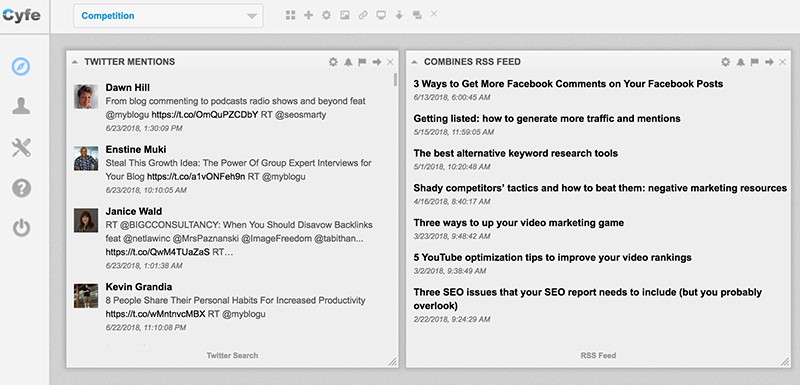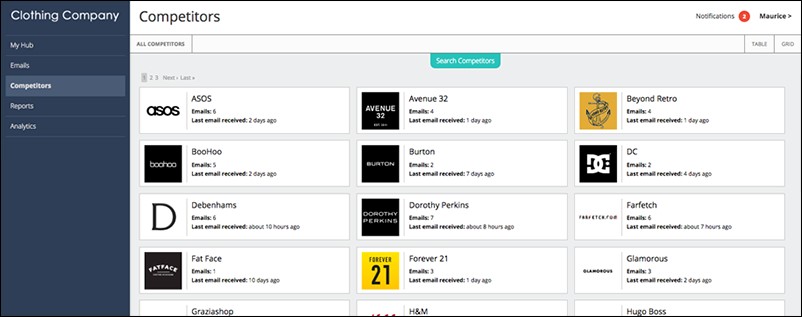Can I tell you a secret? Around one quarter of my content marketing strategy is directly informed by what my competitors are doing. It’s immensely helpful to watch their tactics and see how they work in a real time or historic context. All the information I need is at my fingertips, and I didn’t have to gather, curate or analyze it myself.
Using competitive marketing monitoring is the perfect way to help you to see what your audience (many of whom overlap with those competitors, big or small) are responding to. That gives insight into their needs.
Create your competitive analysis summary
What is it that your customers are looking for right now? Do they have any questions that they are burning to have answered? Maybe you have some information that gives a different perspective on an element of the industry they hadn’t considered.
These are ways in which you can frame your content marketing strategy, part of which is going to come from your own research and labor. The rest will be readily available by watching your competitors and the people they are managing to target.
It is also possible to do your own monitoring through a manual process of curating data.
First, you will need to curate data about your competitor’s content by auditing all of their content, from blogs and podcasts, to videos and social media. Make sure you search for forms of content like webinars, white papers, ebooks and case studies, too.
Once you have a good selection of competitor content, categorize it by Competitor and state what kind of content they make, how often they post it, how much is currently available and the quality. Be sure to notice the finer details, such as length of the most popular posts and the keyword density.
I’ve adapted one of SmartSheet’s templates for this purposes:
[Action items: Download your template here. Then adapt the first column based on what it is you’re going to analyze and monitor. If you plan to collaborate on it with your team, upload it to Google Docs and then use plugins to add it to your WordPress dashboard.]
From there, begin to look at individual pieces and find patterns. What do they do in their most popular pieces? What questions are they answering? What keywords are they targeting within those works?
I will usually make a spreadsheet with this info and update it every few months. It is good to go back and get a full picture of their strategy.
Automating the hunt with competitor monitoring tools
Tools to monitor mentions and writers: Buzzsumo, Google Alerts and Cyfe
Buzzsumo (+Buzzsumo Alerts)
Buzzsumo is one of my personal favorites. It gives you so much information, from web statistics to SEO and social media. It can get a little costly to use the pro version, but it is worth it for most people who want an extensive look at what is going on with other brands, or their own. To try them out you can go to their homepage and carry out a search.
They have all kinds of awesome filters and search operators that allow you to easily dig deeper into your competitors’ content tactics. Author search allows you to search content by a certain writer (e.g. your competitor’s lead blogger) to find all the articles they put outside of their own blog within a certain period of time:
In Buzzsumo Alerts I manage all my competitor monitoring. It works well because their search engine focuses on content, so I get alerts on the mentions that really matter (i.e. those from high traffic blogs and media outlets).
Google Alerts
Google Alerts is a simpler tool that can be used in conjunction with the others, and is an easy way to set alerts for any topic or brand. Create various alerts for different topics, some brand-related and others industry-specific. You can ask it to tell you once per week, day or with every mention.
Sadly, it will give you a fair amount of unrelated content so if you find you are getting too many unhelpful alerts, try specifying your keywords a little more directly.
There are more monitoring tools you can find here and more marketing tools listed here.
Cyfe
Cyfe (Disclaimer: this is my personal content client) is an affordable business dashboard that can be used to monitor almost anything you can think of, including your competitors and their content marketing tactics.
You can create your own custom widgets to form your dashboard and use pre-built ones that include:
- Google Alerts (you can view and archive alerts using the widget)
- Twitter search (you can monitor and archive your competitors’ Tweets – Tweets mentioning them as well as their branded hashtags)
- Google Trends to spot when there’s a spike of interest in one of your competitors
- RSS feeds (to easily combine your competitors’ RSS feeds in one).
Tools to monitor on-page tactics: SE Ranking
SE Ranking is the multi-feature SEO platform that can be used for many purposes, including competitive analysis. One of my favorite features is the Page Changes Monitoring, which sends email alerts any time a page is changed.
Add your competitors’ most important pages there. These may include:
- Core product pages
- Pages that rank for important and expensive search queries
- Pages that attract most backlinks.
Any time your competitor is there to optimize or re-optimize one or many of their key landing pages, you’ll get an email alert and will be able to guess what is going on:
- Have they discovered better keywords (i.e. those that are easier to rank for, those that convert better, etc.) to target?
- Have they found a better way to get their pages featured in search?
- Are they expanding/narrowing their product offering?
It’s also a good idea to monitor your competitors’:
- Home page
- YouTube channel (to get alerted once they add new videos)
- Directory and local category pages (to look out for more competitors being added).
Tools to monitor email marketing tactics: Competitor and Owletter
Competitor.email
I have not personally used Competitor, but I have heard good things from a number of people who have. It views, tracks and analyzes competitor email marketing campaigns in a handy dashboard. The insights look amazing and the reports could be doubtlessly invaluable.
They have a white paper available that talks more about their tool and how you can apply it to your own monitoring and marketing campaign. You can also try a demo version to get an idea of how it works.
Owletter
For a long time, I have been signing up for competitor newsletters. It is a no-brainer way to see how they are managing their email marketing campaigns, but it can get a bit full in my inbox as a result. Owletter solves the issue by making a dashboard with competitor emails, storing, analyzing and reporting on them in one place.
Do you have a tool you think deserves to be on the list? Know a hot tip for monitoring competitor content? Let us know in the comments.



